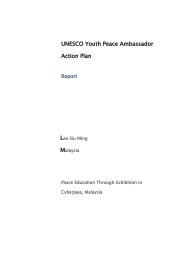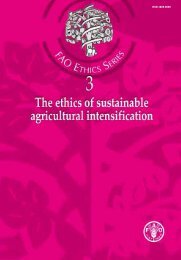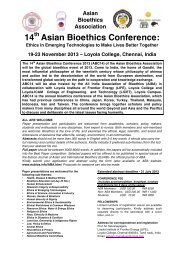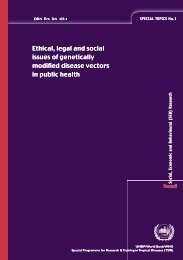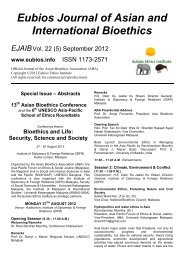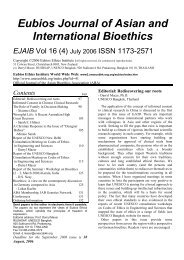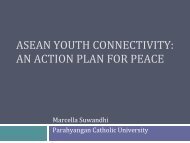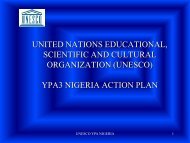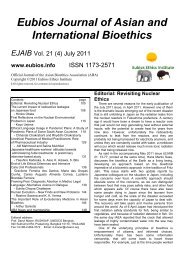Eubios Journal of Asian and International Bioethics EJAIB
Eubios Journal of Asian and International Bioethics EJAIB
Eubios Journal of Asian and International Bioethics EJAIB
You also want an ePaper? Increase the reach of your titles
YUMPU automatically turns print PDFs into web optimized ePapers that Google loves.
148 <strong>Eubios</strong> <strong>Journal</strong> <strong>of</strong> <strong>Asian</strong> <strong>and</strong> <strong>International</strong> <strong>Bioethics</strong> 19 (September 2009)<br />
- Maintenance <strong>of</strong> environmental stability through<br />
preservation <strong>and</strong>, where necessary, restoration <strong>of</strong> the<br />
ecological balance that has been adversely disturbed by<br />
serious depletion <strong>of</strong> the forests <strong>of</strong> the country.<br />
- Conserving the natural heritage <strong>of</strong> the country by<br />
preserving the remaining natural forests with the vast<br />
variety <strong>of</strong> flora <strong>and</strong> fauna, which represent the<br />
remarkable biological diversity <strong>and</strong> genetic resources <strong>of</strong><br />
the country.<br />
- Checking soil erosion <strong>and</strong> denudation in the<br />
catchment areas <strong>of</strong> rivers, lakes, reservoirs in the<br />
interest <strong>of</strong> soil <strong>and</strong> water conservation, for mitigating<br />
floods <strong>and</strong> droughts <strong>and</strong> for the retardation <strong>of</strong> siltation<br />
<strong>of</strong> reservoirs.<br />
- Checking the extension <strong>of</strong> s<strong>and</strong>-dunes in the desert<br />
areas <strong>of</strong> Rajasthan <strong>and</strong> along the coastal tracts.<br />
- Increasing substantially the forest/tree cover in the<br />
country through massive afforestation <strong>and</strong> social<br />
forestry programmes, especially on all denuded,<br />
degraded <strong>and</strong> unproductive l<strong>and</strong>s.<br />
- Meeting the requirements <strong>of</strong> fuelwood, fodder, minor<br />
forest produce <strong>and</strong> small timber <strong>of</strong> the rural <strong>and</strong> tribal<br />
populations.<br />
- Increasing the productivity <strong>of</strong> forests to meet essential<br />
national needs.<br />
- Encouraging efficient utilisation <strong>of</strong> forest produce <strong>and</strong><br />
maximising substitution <strong>of</strong> wood.<br />
- Creating a massive people's movement with the<br />
involvement <strong>of</strong> women, for achieving these objectives<br />
<strong>and</strong> to minimise pressure on existing forests.<br />
It is further reiterated that “The principal aim <strong>of</strong> Forest<br />
Policy must be to ensure environmental stability <strong>and</strong><br />
maintenance <strong>of</strong> ecological balance including<br />
atmospheric equilibrium which are vital for sustenance<br />
<strong>of</strong> all lifeforms; human, animal <strong>and</strong> plant. The<br />
derivation <strong>of</strong> direct economic benefit must be<br />
subordinated to this principal aim.” Thus for the first<br />
time production is preceded by protection, reflecting<br />
the weakening hold <strong>of</strong> anthropocentrism, although more<br />
explicit recognition <strong>of</strong> the rights <strong>of</strong> the non-human<br />
inhabitants <strong>of</strong> forests as well as their intrinsic value<br />
could form the next stage <strong>of</strong> progression.<br />
The forests <strong>of</strong> present-day Pakistan <strong>and</strong> Bangladesh<br />
were also under the purview <strong>of</strong> the 1894 forest policy.<br />
Subsequently, Pakistan has the latest version <strong>of</strong> its<br />
forest policy in 2002, while Bangladesh had framed it<br />
in 1994. Pakistan had also revised the old policy several<br />
times starting in 1955 <strong>and</strong> then in 1962, 1975, 1980,<br />
1991 <strong>and</strong> in 2001. The major objectives in the 1955 <strong>and</strong><br />
1962 versions were generation <strong>of</strong> revenue by increasing<br />
the production. The emphasis was on stricter<br />
government control. The 1975 policy was relatively<br />
“people-friendly”, with more recognition <strong>of</strong> private<br />
rights. In 1980, the National Policy on Forestry <strong>and</strong><br />
Wildlife 1980 was framed as a part <strong>of</strong> the National<br />
Agricultural Policy, 1980. Emphasis was laid on<br />
creation <strong>of</strong> protected areas, increasing the dwindling<br />
forest cover through establishment <strong>of</strong> plantations <strong>and</strong><br />
increasing people‟s awareness.<br />
The 1991 modification <strong>of</strong> this policy first laid explicit<br />
emphasis on consideration <strong>of</strong> social, especially<br />
environmental objectives. As a part <strong>of</strong> the National<br />
Agricultural Policy, the document had the following<br />
objectives: to meet the dem<strong>and</strong>s <strong>of</strong> timber, fuel-wood,<br />
fodder <strong>and</strong> other products; to increase the forest area<br />
from 5.4 percent to 10 percent by 2006; to promote<br />
social forestry programmes; <strong>and</strong> to conserve biological<br />
diversity <strong>and</strong> maintain ecological balance through<br />
conservation <strong>of</strong> natural forests, reforestation <strong>and</strong><br />
wildlife habitat improvement (Shahbaz et al., 2006).<br />
The current version <strong>of</strong> the National Forest Policy 2001<br />
<strong>of</strong> Pakistan “covers the renewable natural resources<br />
(RNR) <strong>of</strong> Pakistan i.e. Forests, Watersheds,<br />
Rangel<strong>and</strong>s, Wildlife, Biodiversity <strong>and</strong> their habitats.<br />
The policy seeks to launch a process for eliminating the<br />
fundamental causes <strong>of</strong> the depletion <strong>of</strong> RNR through<br />
the active participation <strong>of</strong> all the concerned agencies<br />
<strong>and</strong> stakeholders, to realize the sustainable development<br />
<strong>of</strong> the resources. It is an umbrella policy providing<br />
guidelines to the Federal Government, Provincial<br />
Governments <strong>and</strong> territories for the management <strong>of</strong><br />
their RNR. In consonance with it the Provincial <strong>and</strong><br />
District Governments may devise their own policies in<br />
accordance with their circumstances.” “The goal <strong>of</strong> this<br />
policy is to foster the sustainable development <strong>of</strong> RNR<br />
<strong>of</strong> Pakistan, for the maintenance <strong>and</strong> rehabilitation <strong>of</strong> its<br />
environment <strong>and</strong> the enhancement <strong>of</strong> the sustainable<br />
livelihoods <strong>of</strong> its rural masses especially women,<br />
children <strong>and</strong> other deprived groups.”<br />
The key elements <strong>of</strong> the policy are the following:<br />
The first <strong>and</strong> the foremost objective <strong>of</strong> the policy is to<br />
reduce the impact on natural resources from socioeconomic<br />
causes. This involves population planning in<br />
critical ecosystems “such as the wooded mountains,<br />
arid coastal <strong>and</strong> estuarine environments.” The other<br />
components include providing substitutes <strong>of</strong> firewood<br />
such as piped natural gas, LPG, solar energy <strong>and</strong> microhydro<br />
power in the wooded mountain areas. There will<br />
be a focus on “high priority research on reducing the<br />
cost <strong>and</strong> increasing the acceptability <strong>of</strong> substitutes to<br />
firewood such as solar energy, biogas, local coal etc.”<br />
Reducing poverty, poverty <strong>of</strong> opportunity, <strong>and</strong><br />
powerlessness is another focus area which has to be<br />
achieved through “integrated l<strong>and</strong> use projects for the<br />
sustainable rehabilitation <strong>of</strong> RNR with the participation<br />
<strong>of</strong> organized local communities. Such projects not only<br />
provide employment to the rural poor but also improve




